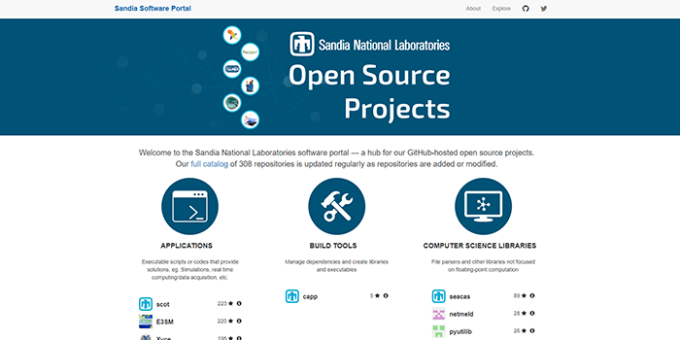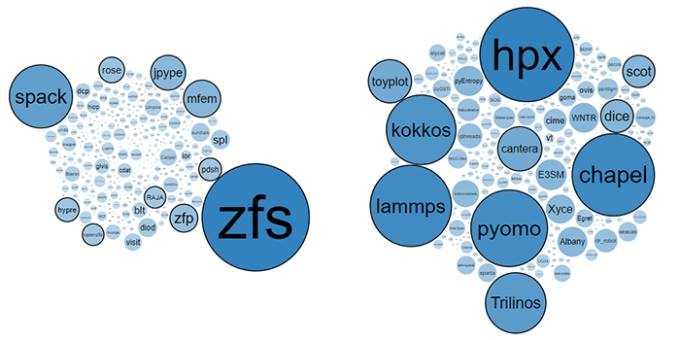Disclaimer: This article is more than two years old. Developments in science and computing happen quickly, and more up-to-date resources on this topic may be available.
Lawrence Livermore and Sandia national laboratories are closely connected through their multifaceted missions for the Department of Energy and National Nuclear Security Administration, and Sandia’s California campus sits just across the street from LLNL in Livermore. Now the two labs share another bond: open-source software. A Sandia software development team has launched a new website based on one of LLNL’s open-source projects.
The new software.sandia.gov website (repository: github.com/sandialabs/sandialabs.github.io) serves as a portal into Sandia’s GitHub repositories, providing more than a dozen browsable categories alongside data visualizations of GitHub data—repository relationships, commit and pull request activity, common licenses, and more. Forked from software.llnl.gov (repository: github.com/LLNL/llnl.github.io), the website is built on a Jekyll template and served via GitHub pages.
“This re-use demonstrates the power of open source to see something that’s almost what you want and adapt it with minimal effort for a different organization,” says Ian Lee, who created LLNL’s software portal and serves as Computing’s Alternate Organizational Information System Security Officer and HPC Security Architect. “Sandia benefits from the work we’ve done, and only needed to apply their own customizations and theming to the site.”
Research software engineer Miranda Mundt and solutions architect Wade Burgess manage the SandiaLabs GitHub organization for Sandia’s Center for Computing Research (CCR), and they came across LLNL’s software website about a year ago. “We wanted to present a solution to our leadership that provided a comprehensive image of what could be possible to display and could be completed relatively quickly,” explains Mundt. “Since we had no desire to reinvent the wheel, we forked the LLNL repository.”
Mundt and Burgess contacted Lee and LLNL software developer Laura Weber when they ran into a few issues during initial setup. “It wasn’t entirely clear what we should change in order to remove the LLNL-specific content. We asked Ian and Laura for guidance, which they swiftly and happily provided,” notes Mundt. “Because of this help, the implementation process was relatively painless. Had we tried to do it completely alone, I’m not sure if we would have been successful as quickly.”
Beyond the necessary branding differences, the two websites vary in meaningful ways for each organization. LLNL maintains a years-long archive of news and a lengthy FAQ page, whereas Sandia omits the news feed and directs Sandians to a regularly updated internal page for open-source policy and procedure information. While LLNL organizes projects into 10 categories, Sandia uses 13—e.g., mini-apps, programming models and runtimes, scientific libraries, visualization—which were determined at a series of open-source town hall meetings with CCR’s workforce.
The Sandia team plans to expand their website to include software projects hosted through other version control systems, such as GitLab and Bitbucket. As the two websites operate independently, any improvements to either one will not automatically benefit the other. But now that the relationship is established, the teams are likely to stay in touch, especially if either one resolves a pesky bug or long-standing issue.
Like LLNL Computing, the CCR has long been active in open-science contributions and cross-institutional collaborations. Burgess, who works with Sandia leadership to establish open-source processes and procedures, states, “We attend and contribute to publications and conferences around the world, and collaborate across numerous institutions. As open-source software is a feature of enabling this work, it’s important to make that path accessible.”
—Holly Auten




